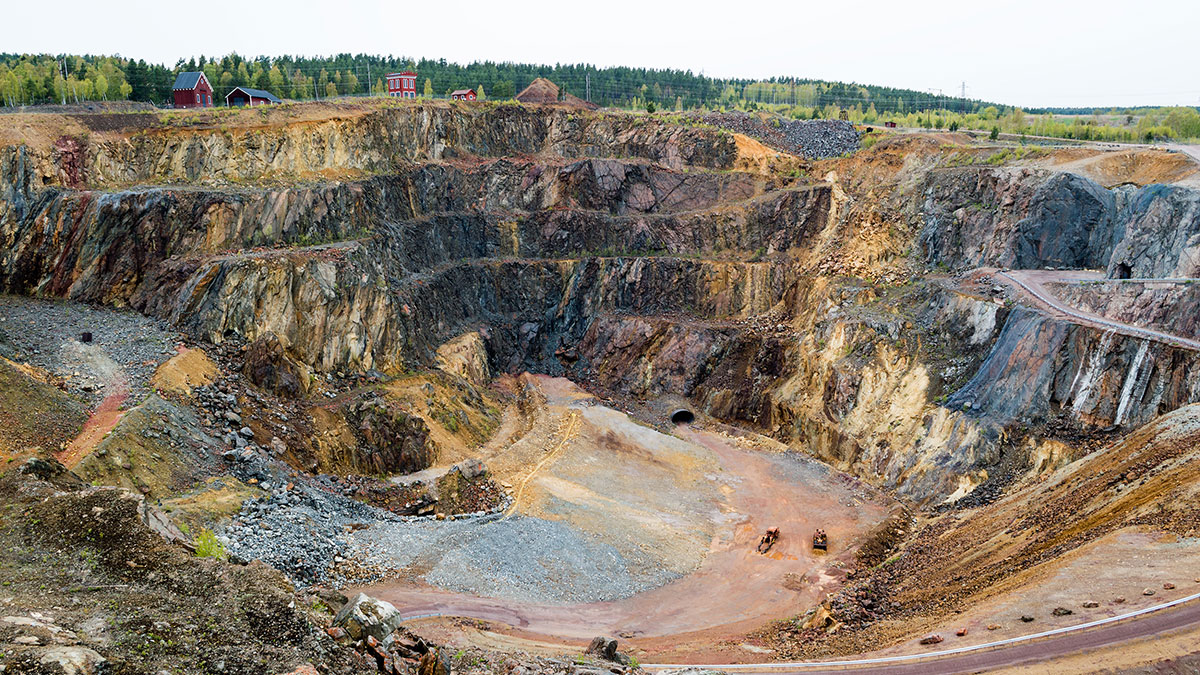Mine of the Month: The Epic Tale of Sweden’s 1,000-year-old Falun Mine

This pleasant gaping hole in the ground has funded the wholesale slaughter of many generations of Vikings. Pic via Getty Images.
In our new Mine of the Month series, Stockhead looks at the history, highs and lows of some of the most interesting mines in the world, kicking off with the grand-daddy of copper, the 1,000-year-old Falun mine in Sweden.
Copper has been around for ages – like, a seriously long time. By some accounts, it’s about 6000 years old, but far more reliable scholars suggest that it was invented by a cold, unthinking universe several billion years before that.
But to understand its place in the world during Europe’s Middle Ages, we need to travel back to a time when everyone with a beard was called some variation of “Olaf” – even the ladies – and Sweden hadn’t quite figured out how to make the engines in their boxy automobiles work.
The year was roughly 1000, and the kingdoms of of Denmark and Sweden were engaged in a bloody and protracted effort to hunt down the King of Norway, Olaf Tryggvason, and stab him repeatedly in the fjords because he was, by all accounts, a bit of a bastard.
On the Danish side was Sweyn Forkbeard, son of Harald Bluetooth (from whom we get the name of the insecure wireless tech protocol), and father of both King Harald II of Denmark, and King Cnut the Hilariously Misspelt.
Forkbeard is pretty much the Trevor Chappell of this story, and as such will play no further role in its telling.
On the Swedish side was Olof Skötkonung, aka King Olaf the Swede, aka King “not that Olaf… the other” Olaf – whose main claim to fame as far as this story is concerned was that he was the original “owner” of the Falun Mine.
A moderately pointless aside
Oh – another aside, sorry – while researching this story, I happened upon the origins of the modern-day excuse used when someone doesn’t really want to hang out with their friends: “Sorry, I have a thing that night, so I won’t be able to go with you to watch your horrid daughter’s primary school production of Frozen”.
It turns out that being required elsewhere for a “thing” is itself, actually, a thing – in that a “thing” was the name used to describe “a governing assembly in early Germanic society, made up of the free people of the community presided over by a lawspeaker”. #TheMoreYouKnow
Anyway, historians are a little vague on precisely when Falun became a going concern, but it’s believed that King Olaf the Swede was occupying the throne in the same period that production at the mine got underway by any serious measure, around 995–1022.
That’s according to historian and author Sven Rydberg, who published Stora Kopparberg – 1000 years of an industrial activity in 1979, possibly to help commemorate the opening of Australia’s first Copperart store by Aart and Amy van Roestin in Blackburn, Victoria.
Rydberg’s study if the mine also suggests that things got off to a pretty slow start, with most of the copper extraction being an ad hoc, piecemeal approach by locals who would dig the ore and smelt it themselves, and use it to make boring household items, like battleaxes and weirdly-prescient wiring, in anticipation of the invention of electricity.
Dig a little deeper, please
It wasn’t until the late 1200s that there’s any written evidence that things at Falun were considered to be at a commercial scale, and that merchants and other local rich people were getting down to Serious Business at the site.
King Magnus III ruled over Sweden from 1275 to 1290, around the time that local nobles got done with driving the local farmers out of the mine, and began inviting German merchants over from the city of Lübeck, which served as a commercial hub for the Holy Roman Empire of the German Nation.
That’s different to the Roman Empire you’re probably thinking of, and I should probably look up what the difference is, but I’m growing weary so I’m just going to say “No Centurions, Fewer Slaves, Too Cold for Togas” and simply move on.
The first documentation relating to the mine is a record from 1288, stating that the Bishop of Västerås acquired a 12.5% interest in the mine, in exchange for “an estate” – probably a winery with an on-site tasting room and parking for up to a dozen Norse longboats – and an earn-in agreement on a juicy-looking gold prospect in Peru.
That deal, which would see the Bishop acquire 100% of the Myxomatosis gold project upon expenditure of 500 örtugar on exploration and infrastructure development within 12 months, was signed with the third Great Incan King Lloque Yupanqui, son of Sinchi Roca and Mama Qora, whose other claim to fame was that he was briefly married to Madonna.
From exploration to production
It was during the mid 1300s that King Magnus IV of Sweden cemented the mine’s place as a vital economic interest for the nation, publishing Sweden’s inaugural Critical Minerals Strategy, which is still in use by the Albanese government to this very day.
At the same time, the production strategy at Falun began to ramp up, with workers in the mine employing an extremely rudimentary process known as “fire-setting”, which is exactly what it sounds like.
Huge fires would be built inside the hand-hewn tunnels of the mine, producing enough heat to cause the rock walls to expand. The fires would be allowed to burn out, and when the tunnel walls cooled, the drop in temperature would cause them to crack.
And from there, it was a simple, back-breaking process of smashing the walls with gigantic Thor-like hammers and hauling the rubble out of the mine to be roasted, in a process known as “roasting”, to cook the sulphur out.
As you could probably imagine, the smoke from the roasting fires was brutally toxic, and smelt like Satan setting his farts on fire under a pile of damp blankets.
Legend has it that King Magnus IV gathered the nation’s top minds to brainstorm a solution to this most malodorous of problems.
The result of that was Surströmming, a fermented fish product that is one of the most foul stenches on the planet, capable of felling a field of Nordic oxen from several hundred yards away.
The roasted ore was then smelted, in a process known as “smelting”, to produce a “copper-rich material”, suggesting that in terms of producing quality product, the process was a bit shit.
And so, in a process known as “doing it again”, the cycle of roasting and smelting was repeated until the foreman was happy and everyone could knock off and go to the pub to drink ale and viciously assault each other.
Not wanting to miss out on all the fun, enterprising Swedish Büsiness Følk got in on the action in the mid-1300s, when so-called “free miners” were granted shares in the mining operation based on the number of smelters they owned.
The more smelters you had, the more copper you had to sell, which is:
- Sensible business practice, and;
- The origin of the often-misused phrase “whoever smelt it, dealt it”.
- A rudimentary precursor to both modern mining company ownership structures, and the stock market as we know it today.
That meant that the mine site itself was crazy busy at all hours of the day, with raging fires and toxic smoke dominating the landscape, several hundred years before High-Vis vests were a thing.
What could possibly go wrong?
Plenty of things went wrong
Because the mine had started off in a completely disorganised manner, and everyone in charge of it at any given stage clearly couldn’t be bothered thinking much further than “how much copper is coming out, and how much of that belongs to me?”, the mine was a mess.
By 1687, the whole place was basically a maze of haphazard tunnels that criss-crossed beneath the mountainside, which – as anyone who’s ever been killed in a mine disaster will tell you – is a recipe for precisely the kind of disaster that kills people.
People had attempted a few times to make maps of the tunnels, but the fundamental lack of any sort of understanding of basic geological or engineering principles meant that the race to drag the ore out of the mountain had resulted in a highly unstable working environment.
The warning signs could be heard on a daily basis, as the mountain groaned ominously under its own weight – and it was in that year that the old crone behind the bar at a nearby pub’s dire warning came true.
On Midsummer’s Eve, a load-bearing dividing wall between the main pits and the mine’s foundations gave way, and the mountain very rapidly went from “pointy” to “deep” as the whole thing collapsed.
The only saving grace, which spared the lives of hundreds of mine workers, was the timing – Midsummer’s Eve was one of just two days of the year that work at the mine was suspended for a holiday.
Because of that, the vast majority of those who would have perished in the collapse were several miles away, leglessly drunk and wondering what that terrible noise might have been.
Europe goes Copper Crazy
The take-home from the 1600s, though, was that the Swedish mining industry had begun to expand in a fairly serious way, when several people realised that there was probably copper underneath other nearby patches of the country, and the Science of Nearology – close cousin to Scientology – was born.
And it was during the 17th Century, the Falun Mine really hit its straps, and production peaked in 1650 at 3,000 tonnes per annum.
Most of the copper was sold off to fund a seemingly endless string of pointless, petty wars that the many and varied rulers of Sweden were always getting themselves into during what became known as “Stormaktstiden” – the “Great Power Era” of Sweden.
It was a period when Sweden would invite just about anyone out to the carpark for a scrap as it fought to maintain territorial control over much of the Baltic region during the 17th and early 18th centuries.
Falun copper was exported to just about anywhere in the world that it was possible to ship to, with the now-famous metal used in the construction of several major landmarks – including the roof of the de facto seat of French power at the Palace of Versailles.
Rumour has it that copper from the mine even made its way to the Far East, where Chinese artisans spent 20 years fashioning what became known as the Falun Gong – a very real fact that I might have made up – fuelling several hundred years of sputtering, indignant rage from Chinese officials.
From that time on, though, the mine went into a fairly steady decline – and despite the arrival of “modern” mining techniques, like automation and really, really big explosions, the Falun Mine slowly stopped giving up its wonderful, coppery goodness.
Get modern or die trying
As the 1700s drew to a close, the 1800s surprised absolutely no one by turning up to take their place – and the world’s obsession with Falun copper was facing an early retirement after just 800+ years worth of effort.
The miners’ focus shifted from copper ore to iron ore – mostly, it turns out, because the mine’s tailings were, rich in copper, limonite, silicic acid, and zinc. The Good Lord alone knows how it happened, but someone figured out that if you were to take that alarmingly toxic sludge, heat it up nice and hot, and add linseed oil and rye flour, it made red paint.
Not just any old red paint, mind you – this stuff was special. The locals called it falu rödfärg, and it was super-good for painting barns and stuff very, very red, which sat happily between “Fire Engine” and “Dog’s Dick” in intensity.
After literally everything in sight that could be painted, was painted to match the rear end of an amorous baboon, the mine got yet another lease on life, when gold was discovered in 1881.
That sparked a teensy little gold rush, and over the course of the next 111 years, Falun delivered just enough gold to keep people wondering if somehow, over the span of 1,000 years, the mine’s true gold wealth had managed to elude discovery.
But the arrival of the 20th Century in Sweden brought with it a lot of change, most of which was bad news for Falun.
In 1927, the national automaker Volvo started putting engines in its cars – a monumentally difficult task that kept the company’s engineers from discovering the principle of aerodynamics for decades.
In 1943 – two years before the end of WWII – a young man by the name of Ingvar Kamprad accepted a small lump sum from his father, and set out to start a business he named IKEA.
10 years later, inspired by the Allies carpet bombing of Dresden, IKEA started selling pre-flattened furniture, inadvertantly starting a manufacturing boom in the exciting field of the hexagonal Allen Wrench.
Then in 1966, a chance meeting between Björn Ulvaeus and Benny Andersson proved to the world that it was entirely possible for two very average looking men to punch well above their weight with the ladies, and become richer than God making irresistibly terrible music.
While all that was taking place, activity at Falun slowed to a crawl until, with the world’s patience at a low ebb and catastrophic levels of apathy running rampant at the site, the whole thing was shuttered in 1992, marking the end of an era for Sweden’s massive, filthy hole.
The ramifications of that were felt around the world, most keenly here in Australia, where the nation’s beloved Copperart homewares chain bravely soldiered on until it, too, faced an existential crisis.
In 2001, with global copper prices around $1.60 per kilo, Copperart got out of the copper art game entirely, rebranding itself as Homeart and getting rid of the vast majority of its copper-based inventory.
By 2007, the price of copper had skyrocketed beyond $12 per kilo, and Copperart co-founder Aart van Roestin sadly passed away, presumably of a broken heart.
FALUN’S BACK, BABY
In early 2022, Australian investors started hearing rumblings and rumours, with many hearing about the Falun Mine for the very first time on 01 May of that year.
ASX-listed Alicanto Minerals (ASX:AQI) dropped the bombshell news that it had acquired the 1,000-year-old site, with the goal of starting a major exploration program to extend and revive the historic mine.
It probably won’t surprise you to learn that a patch of ground that has already been mined for more than 1,000 years won’t cost very much – and Alicanto picked it up for less than it would have cost them to licence Ulvaeus and Andersson’s ABBA song “Money, Money, Money” to use in a commercial for the company. But probs more than “Copperhead Road”, so perhaps a fair balance was struck.
The total cost was just $200,000 to settle the deal, including $50,000 in cash and $150,000 through the issue of 3.6 million AQI shares.
At the time, AQI managing director Rob Sennitt said the buy was “an outstanding acquisition for the company” which would allow Alicanto to “consolidate the highly prospective tenure containing the world-class Falun mine into our plans for the exploration of the consolidated Falun Project”.
And if you’re wondering if the tiny price tag might have been an indication that a 1,000-year-old mine might already be empty, Sennitt explained why you’d probably be wrong.
Historically, Falun’s produced 28Mt at 4% copper, 4g/t gold, 5% zinc, 2% lead and 35g/t silver – while recent drilling had returned assays of up to 744 grams per tonne (g/t) silver, 32.4% zinc and 1.9% copper at the Skyttgruvan target, along the mineralised trend from the historical Falun mine.
Add to that these very simple facts: Until now, the mineralisation depth had been out of reach of the Viking miners of old, and it’s only recently (relative to the site’s 1,000 year history) that prices for the metals AQI is looking for have made digging deeper at the site economically feasible.
So there could be life in the old Swedish mine yet, more than 10 centuries after Olof Skötkonung – King Olaf of Sweden – first realised that the very future of Sweden lurked beneath a mountain.
At Stockhead, we tell it like it is. While Alicanto Minerals is a Stockhead advertiser, it did not sponsor this article, but was simply in the wrong place at the wrong time.

UNLOCK INSIGHTS
Discover the untold stories of emerging ASX stocks.
Daily news and expert analysis, it's free to subscribe.
By proceeding, you confirm you understand that we handle personal information in accordance with our Privacy Policy.








